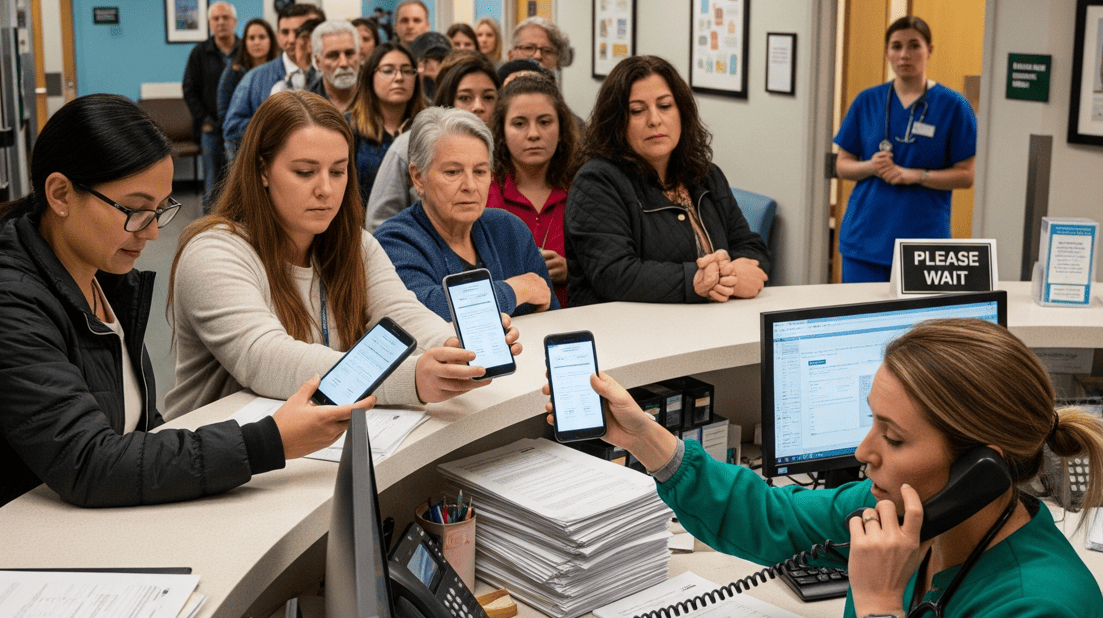4 Signs Your Healthcare Communication System Is Failing You
💡Four warning signs of healthcare communication problems include staff overwhelmed by phone calls, rising no-show rates, EMR gaps, and patient...
7 min read
Gregory Vic Dela Cruz : 8/22/25 10:00 AM

In medical practice, behind the busy front desk lies a silent drain on revenue: poor communication. Missed appointment reminders, confusing instructions, and endless phone calls cost clinics thousands of dollars every year. Poor communication in healthcare practices, whether big or small, are making practitioners and administrators rethink their workflows.
In this article, we’ll uncover the real costs of communication inefficiencies. We’ll quantify the impact of missed reminders and wasted staff time, explain how these breakdowns affect patient satisfaction and compliance, and highlight how integration solves the problem. You’ll also see real-world outcomes from clinics that adopted better systems.
If your team is stuck in endless phone tag or struggling with no-shows, this is your roadmap. Read on to learn how you can stop those unnecessary revenue leaks and restore the trust of your patients.
Research shows that the cost of poor communication in healthcare is one of the largest preventable financial leaks in medical practices. Aside from finances, there's also a reputational damage caused when workflows break down. From no-shows to compliance gaps, these inefficiencies silently eat into revenue margins. For many clinics, these losses are hidden in plain sight—normalized as “just the way things are.” But in reality, they’re avoidable costs that add up to tens or even hundreds of thousands of dollars annually.
No-shows are one of the most direct financial hits to clinics. Without reliable reminders and confirmations, missed appointments can reach 20–30% of bookings. If a practice averages $150 per visit and sees 100 patients weekly, that’s a $3,000 weekly loss—over $150,000 annually. Providers lose billable time, patients delay needed care, and staff scramble to refill empty slots. The cost of poor communication in healthcare starts here, but it doesn’t end here.
When reminders, intake, and billing aren’t automated, staff spend hours every day doing repetitive work. A receptionist who spends three hours daily confirming appointments wastes nearly 750 hours a year—worth over $15,000 in labor. Multiply that across multiple staff members, and the figure balloons. More importantly, every hour spent on repetitive tasks is an hour not spent improving patient experience.
Communication gaps create compliance exposure. HIPAA requires secure, documented communication with patients. But when reminders are sent through unsecure channels or consents are misplaced, practices face penalties ranging from $100 to $50,000 per violation. Beyond fines, missing documentation puts patients at risk and undermines trust. For clinics, one misstep can mean months of lost revenue.
Poor communication doesn’t just frustrate—it drives patients away. Surveys show 70% of patients are more likely to switch providers after communication failures. Each lost patient represents thousands of dollars in lifetime revenue. Negative reviews compound the damage, discouraging new patients from choosing your clinic. In the era of digital-first healthcare, communication is the foundation of patient trust—and losing it is costly.
Administrative overload from poor communication drives burnout. Turnover costs clinics 20–30% of a staff member’s salary in recruitment and training. A burned-out team isn’t just expensive to replace—it creates gaps in service, slows down workflows, and makes errors more likely. Staff want to contribute meaningfully to patient care, not spend hours leaving voicemails or scanning paperwork.
Most clinics use a patchwork of tools—phone systems, portals, emails, paper, and EMRs that don’t talk to each other. Staff act as “bridges,” copying data between systems. Every manual transfer adds time and introduces error. Technology silos also make it nearly impossible for leaders to get a full picture of workflow efficiency. Instead of streamlining care, these tools create bottlenecks that strangle growth.
Follow-ups after procedures, chronic care visits, or preventive screenings often slip through the cracks without automated workflows. Missed follow-ups mean lower continuity of care, poorer patient outcomes, and lost billing opportunities. Over time, these missed visits translate into both worse health outcomes for patients and tens of thousands in lost revenue for clinics.
Today’s patients share their frustrations online. Poor communication is one of the most common complaints in negative reviews on platforms like Google and Healthgrades. A handful of one-star reviews can dissuade dozens of prospective patients, representing thousands in potential lost revenue. Conversely, fixing communication gaps often generates a surge of positive reviews that become a growth engine.
Each of these issues builds on the others. No-shows reduce revenue, which limits hiring. Understaffing increases workloads, which worsens burnout. Burnout creates errors, which fuel compliance risks and bad reviews. Patient trust erodes, retention drops, and the cycle repeats. What feels like small inefficiencies snowball into systemic problems costing clinics thousands every year.

Curogram was built to eliminate the cost of poor communication in healthcare by serving as the missing integration layer between your EMR and patient interactions. By automating reminders, enabling HIPAA-compliant texting, digitizing intake forms, and streamlining billing, Curogram turns costly inefficiencies into measurable savings. Each feature directly addresses a revenue leak.
No-shows shrink dramatically with Curogram’s automated reminders. Instead of generic notifications, reminders are personalized by appointment type, provider, and prep instructions. Messages are delivered via SMS, email, or voice at the right time, in the patient’s preferred language. Patients confirm or reschedule with a tap, with updates syncing back to the EMR in real time. Clinics report up to a 30% reduction in no-shows—tens of thousands in annual savings.
Calls and voicemails drag staff down. With Curogram’s secure texting, patients can confirm visits, ask questions, or upload documents instantly. Staff manage multiple conversations from one dashboard, reducing call volume by 50%. Messages are HIPAA-compliant, permanently logged, and tied to patient records. Staff save hundreds of hours annually, while patients enjoy communication on their terms.
Curogram’s online forms replace clipboards with mobile-friendly documents patients complete before visits. Insurance cards can be uploaded securely via photo, and consents signed digitally. Data flows directly into the EMR, eliminating scanning or re-entry. Check-in times drop by 50%, staff errors decrease, and providers walk in with complete context. The result: smoother visits and happier patients.
Billing is another major revenue leak. Curogram’s text-to-pay feature allows clinics to send secure payment requests directly to patient phones. Payments post back to the EMR and billing system automatically. No follow-up calls, no stacks of unpaid statements. Clinics see stronger cash flow and shorter A/R cycles—while patients enjoy convenience.
Every communication in Curogram is automatically logged, creating a permanent audit trail. During audits, staff can instantly pull complete records of reminders, messages, and consents. This eliminates compliance gaps and protects clinics from costly HIPAA penalties. Instead of scrambling for paperwork, administrators gain confidence and peace of mind.
Curogram dashboards track no-show rates, response times, intake completion percentages, and collections. Leaders use this data to refine workflows continuously. For example, shifting reminder timing from morning to evening boosted confirmations by 20% at one practice. These insights make improvement measurable and sustainable, ensuring clinics never backslide into inefficiency.
Whether you’re a single-location practice or a multi-site group, Curogram adapts. Templates standardize reminders and forms while allowing for local customization. Staff rotating between sites use the same workflows, reducing training needs. Leadership sees consistent data across locations, driving system-wide improvements. Integration isn’t just for big hospitals—Curogram makes it practical for every clinic.
Ultimately, Curogram is more than a software upgrade. It’s a shift from fragmented, reactive communication to streamlined, proactive workflows. Clinics that adopt integration reduce burnout, improve patient satisfaction, and increase revenue. In a competitive healthcare market, the ability to communicate clearly and consistently is not optional—it’s a strategic advantage.
With automated reminders synced to the EMR, clinics see up to a 30% drop in no-shows. For a mid-sized practice, that means recovering $100,000+ annually in billable revenue. Providers stay productive, patients stay on track, and schedules run smoothly.
Two-way texting cuts phone calls in half. Staff save hundreds of hours annually, reallocating time to higher-value activities. Patients appreciate quick answers without being stuck on hold. The result is both measurable efficiency and improved patient satisfaction scores.
Mobile intake forms reduce check-in times by 50%. Patients spend less time in waiting rooms, while staff avoid scanning or typing errors. Providers walk in with complete information, reducing appointment delays and improving clinical accuracy.
Text-to-pay shortens collection cycles significantly. Instead of waiting weeks for mailed statements, payments are completed within hours of a visit. For clinics with tight margins, this predictable cash flow stabilizes operations and funds growth.
Automatic audit trails ensure every communication is documented. Clinics avoid costly HIPAA penalties and gain peace of mind during audits. Compliance becomes effortless rather than stressful.
When staff spend less time on repetitive tasks, burnout drops. Happier teams stay longer, reducing turnover costs. Patients feel the difference in every interaction—shorter waits, clearer communication, and more engaged staff.
The cost of poor communication in healthcare is real and measurable. From missed visits to wasted labor, compliance gaps to lost patients, clinics bleed thousands each year. But these losses are preventable. With Curogram, every leak has a solution—automated reminders, secure texting, digital intake, text-to-pay, and compliance tracking.
Here’s what clinics achieve with Curogram:
The choice is simple: continue leaking revenue or integrate your communication systems. Book your free demo today and see the impact Curogram can make in your practice’s finances.
No. EMRs are designed for documentation, not engagement. Integration with a platform like Curogram adds texting, reminders, forms, and payments—turning the EMR into a complete communication system.
Practices report measurable results within weeks. Reduced no-shows, faster check-ins, and improved collections generate ROI quickly, often covering the system’s cost in the first month.
The process is simple: request a demo, connect your EMR, and launch within days. Staff training takes minutes, and patients adopt it easily since it works directly from their phones.

💡Four warning signs of healthcare communication problems include staff overwhelmed by phone calls, rising no-show rates, EMR gaps, and patient...

💡Secure, HIPAA-compliant texting is the future of healthcare communication. Transform your workflows with enterprise secure medical texting today.